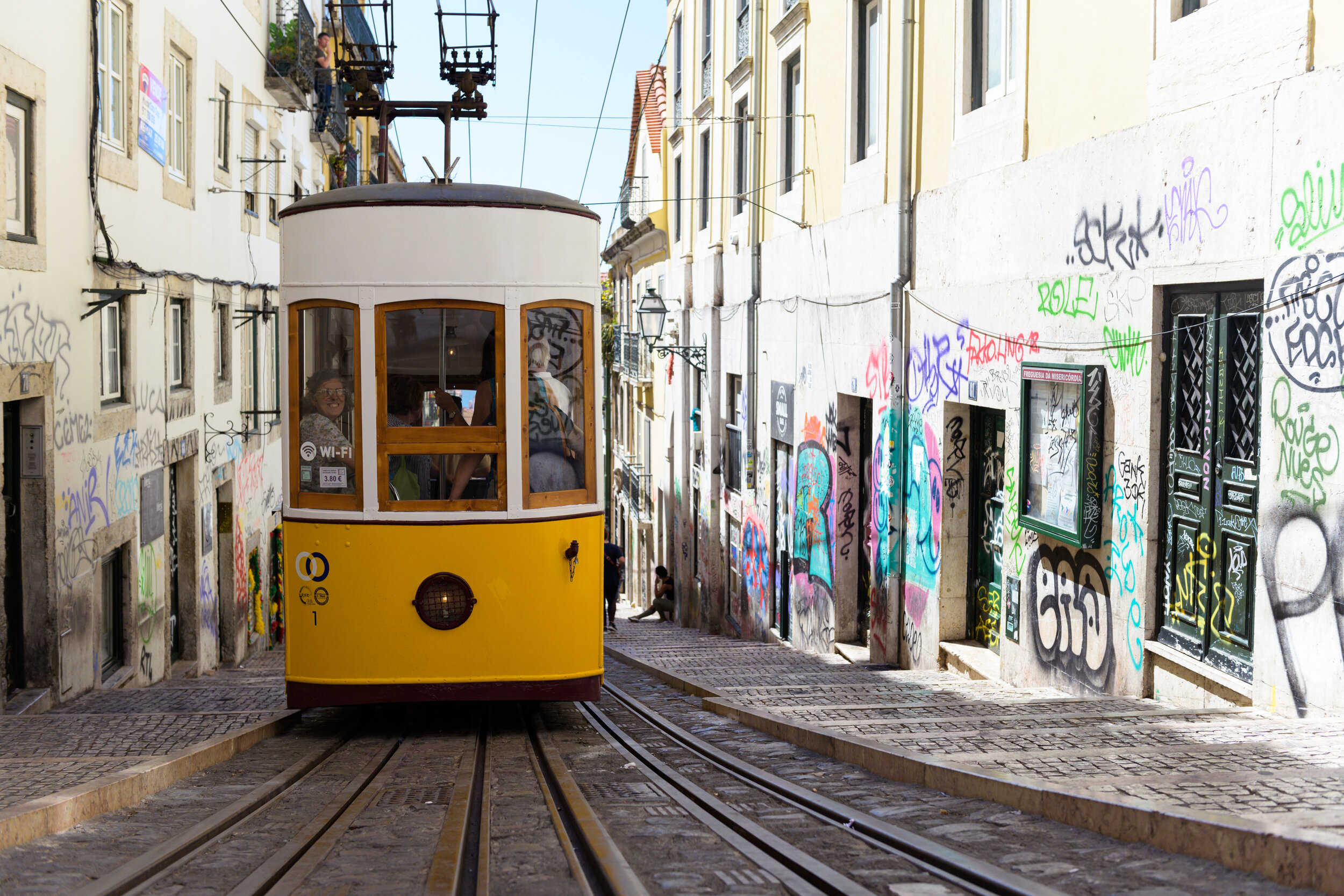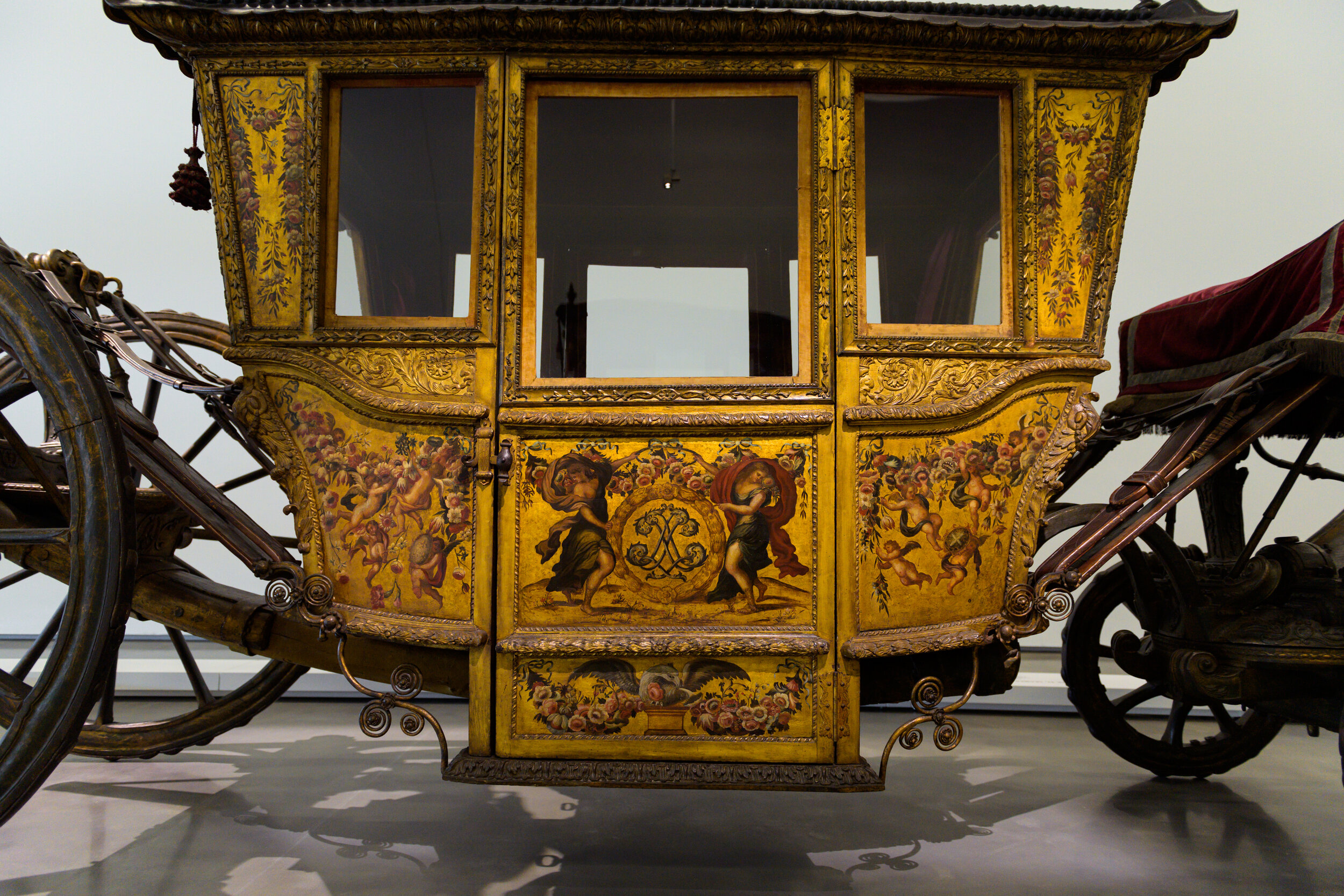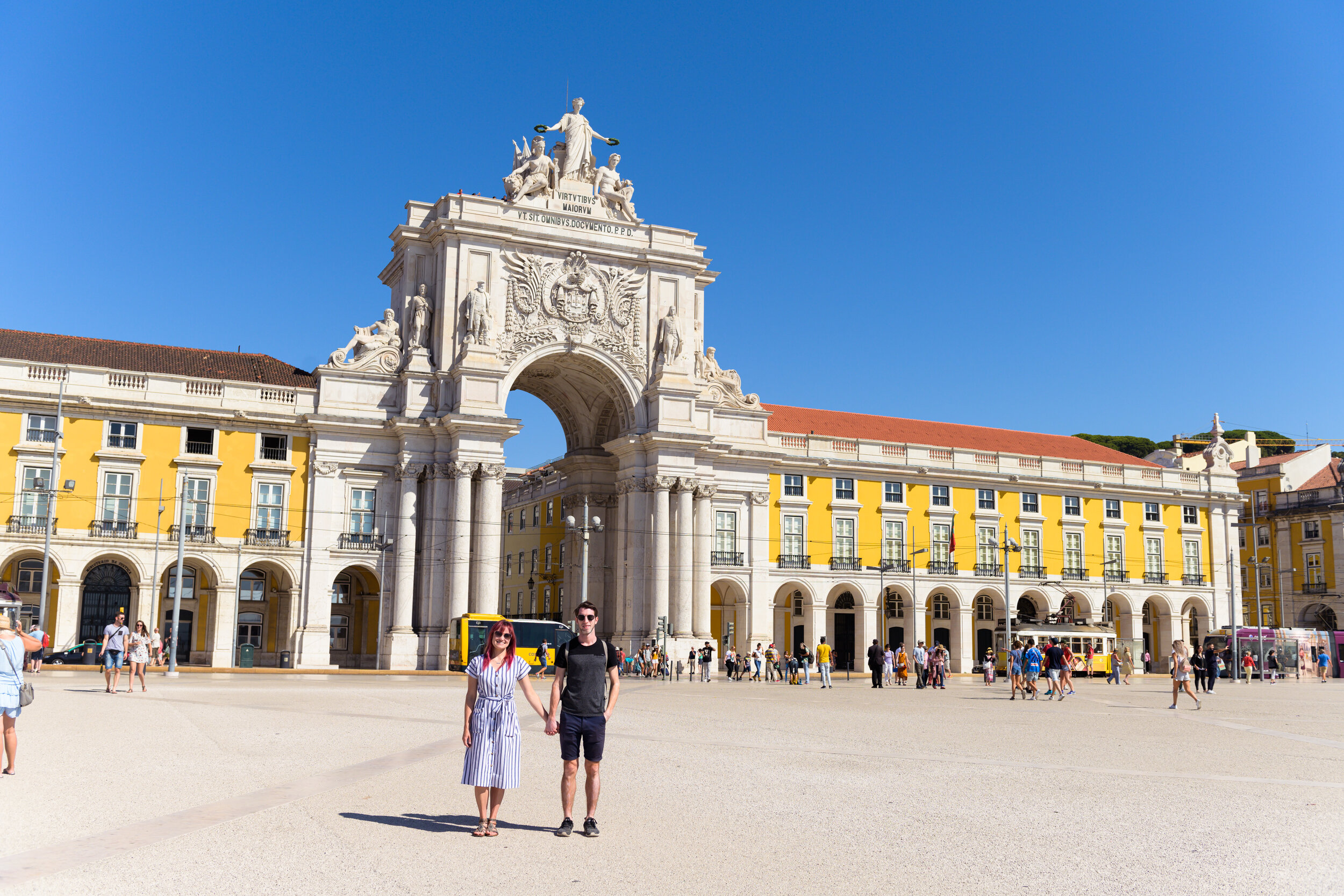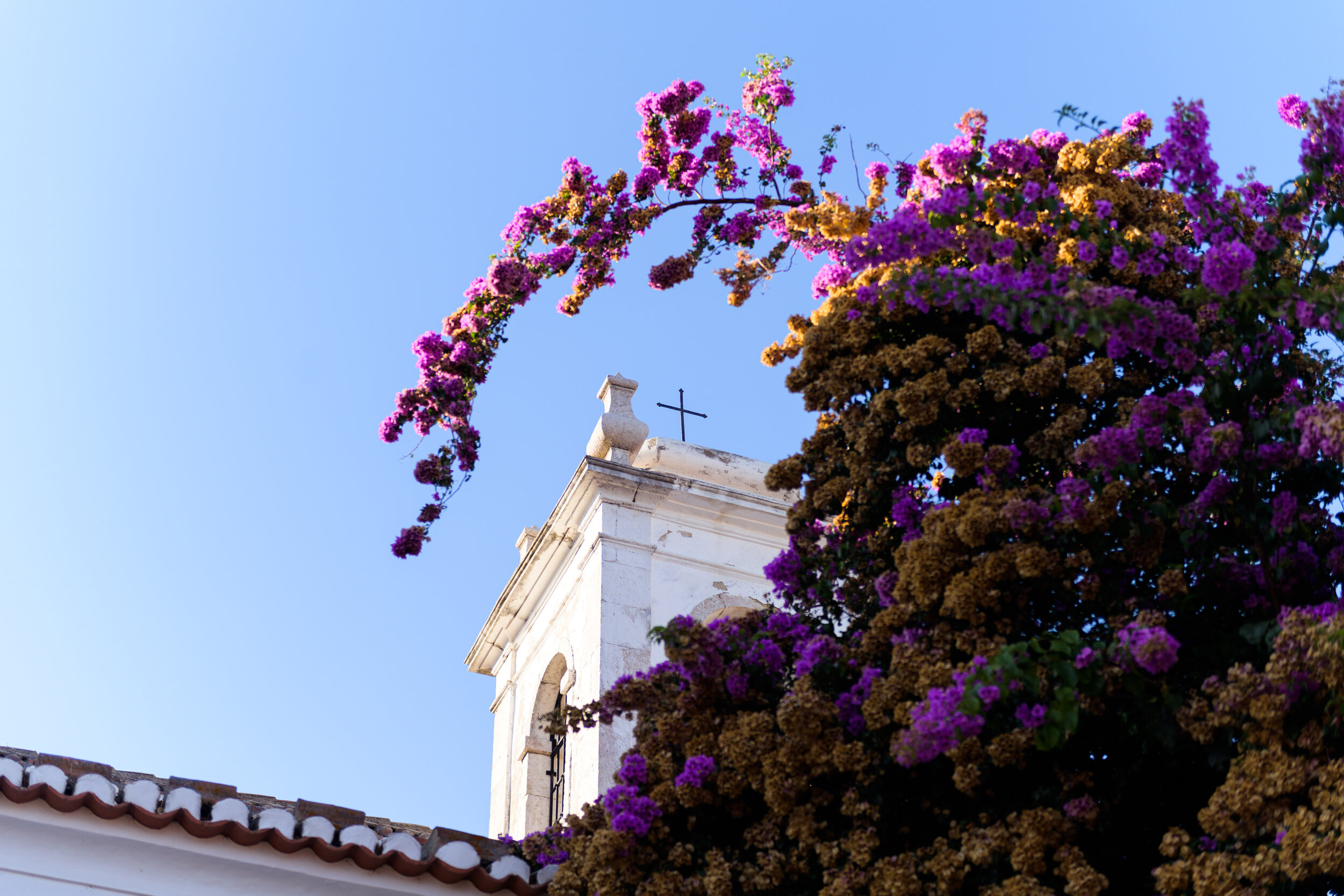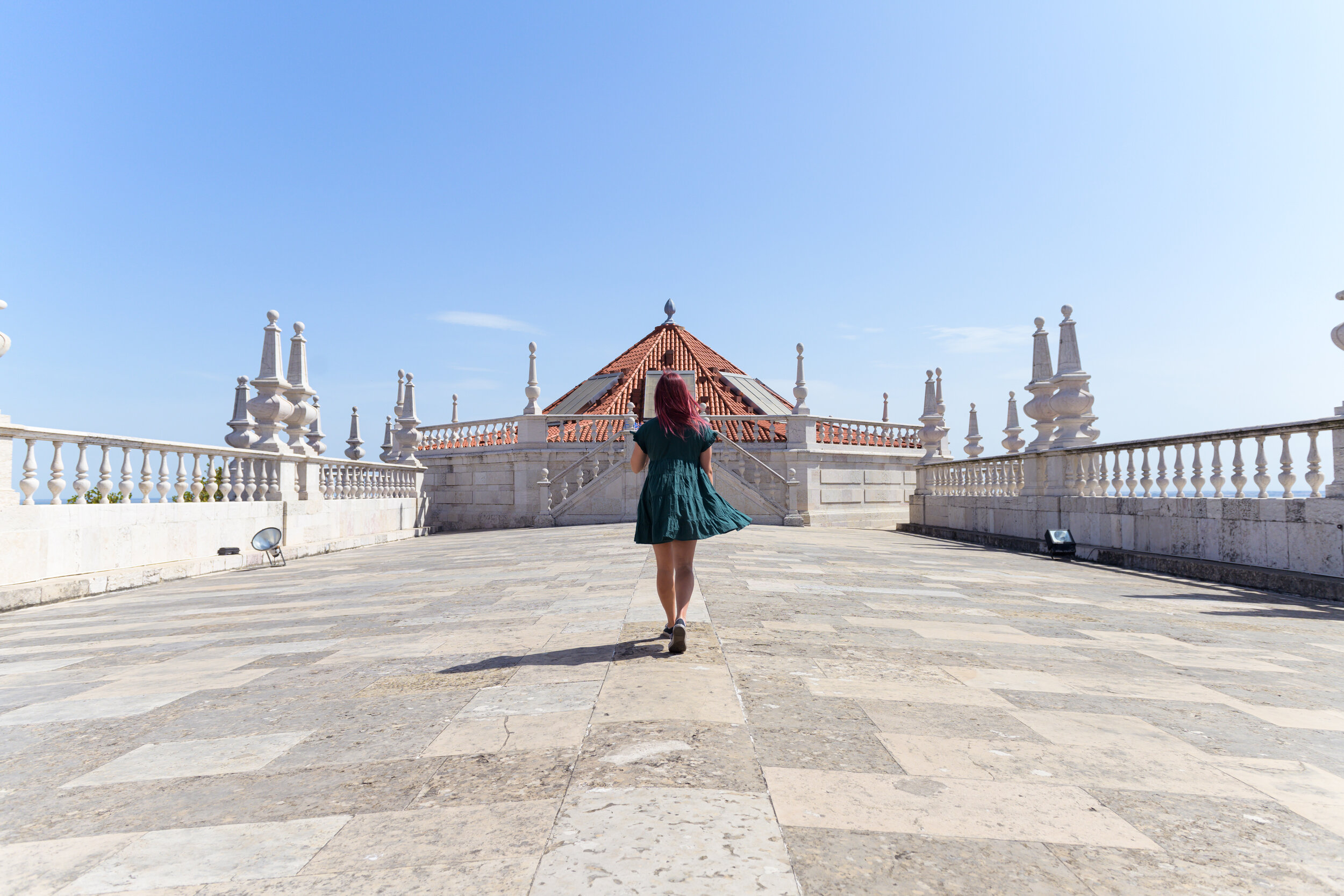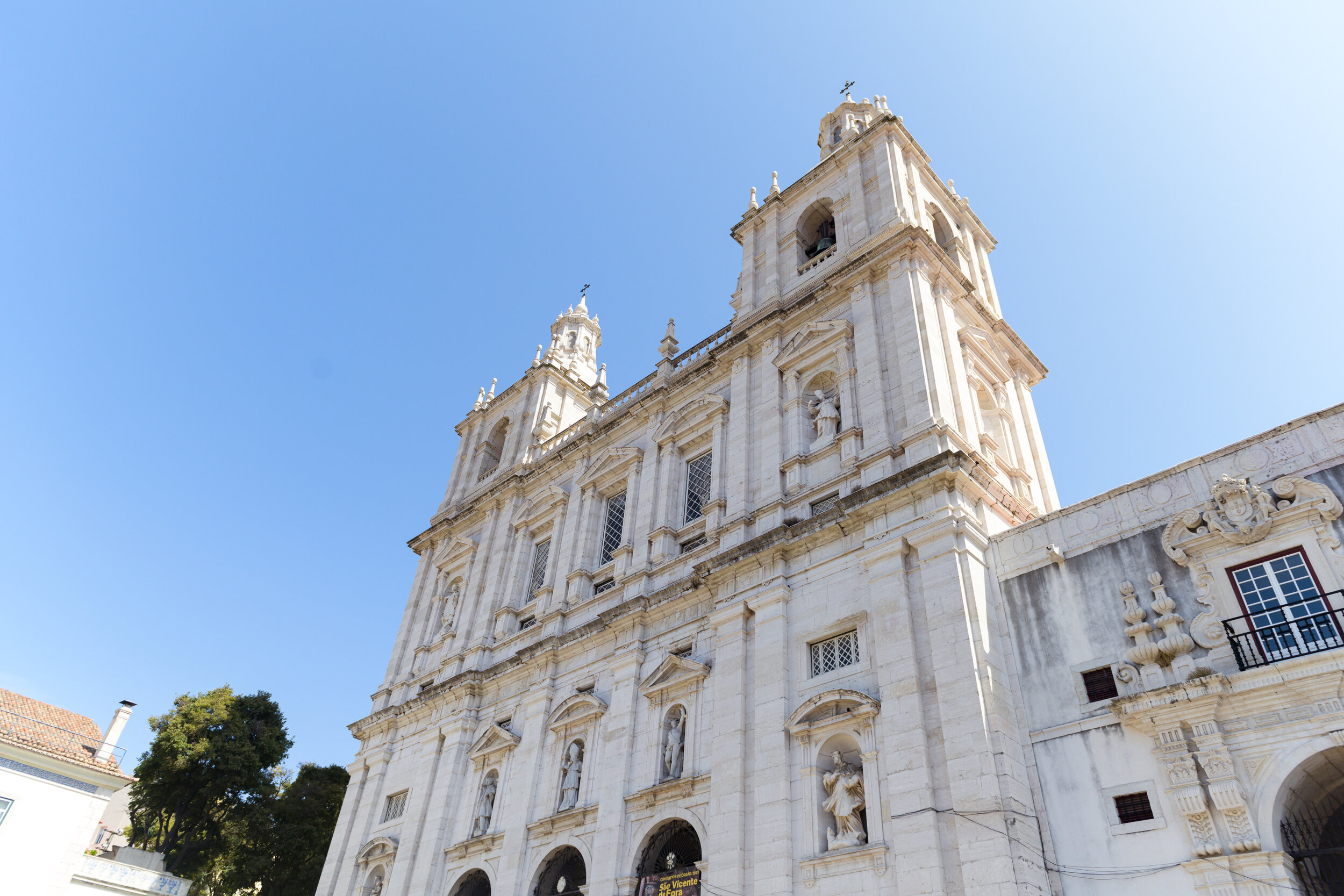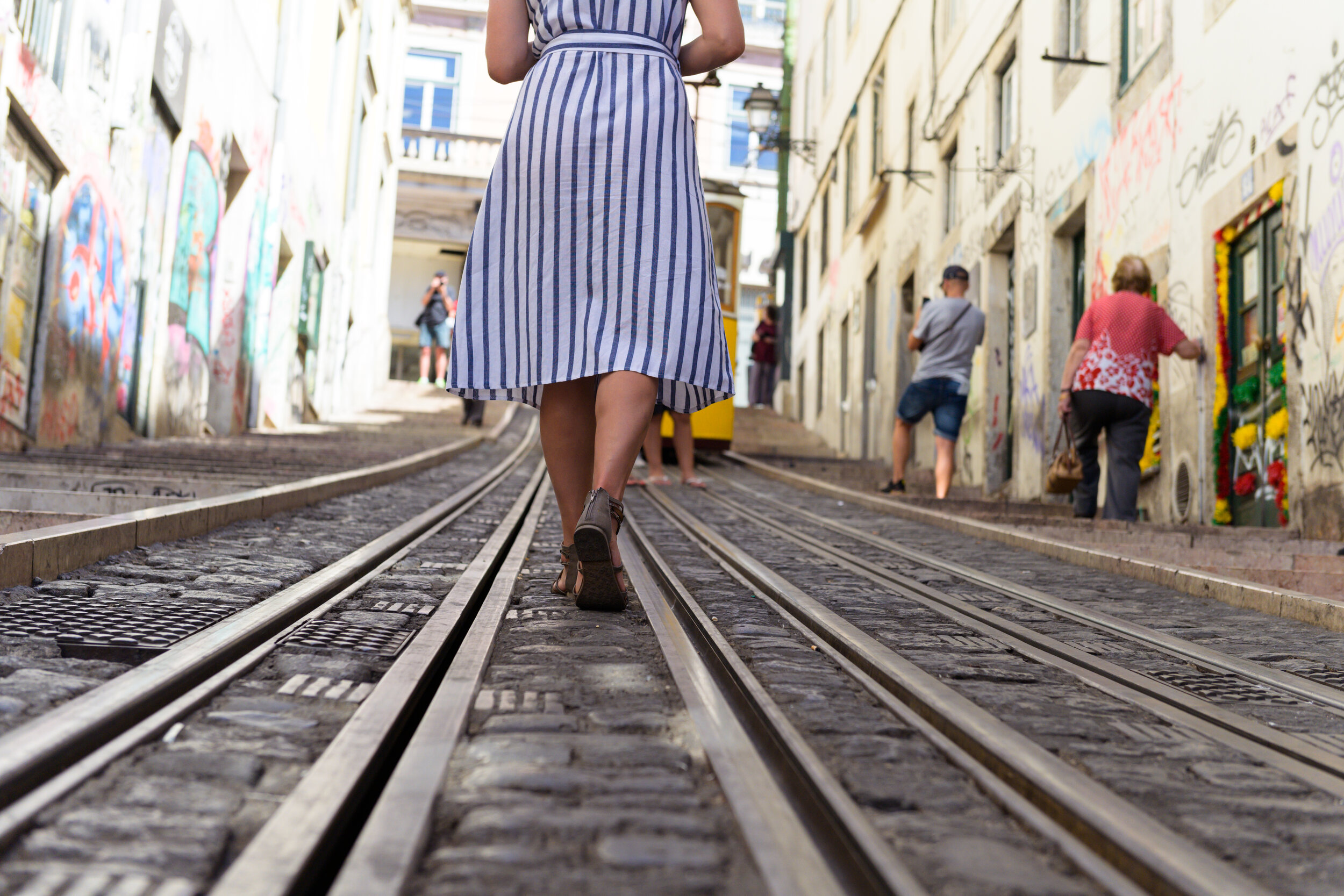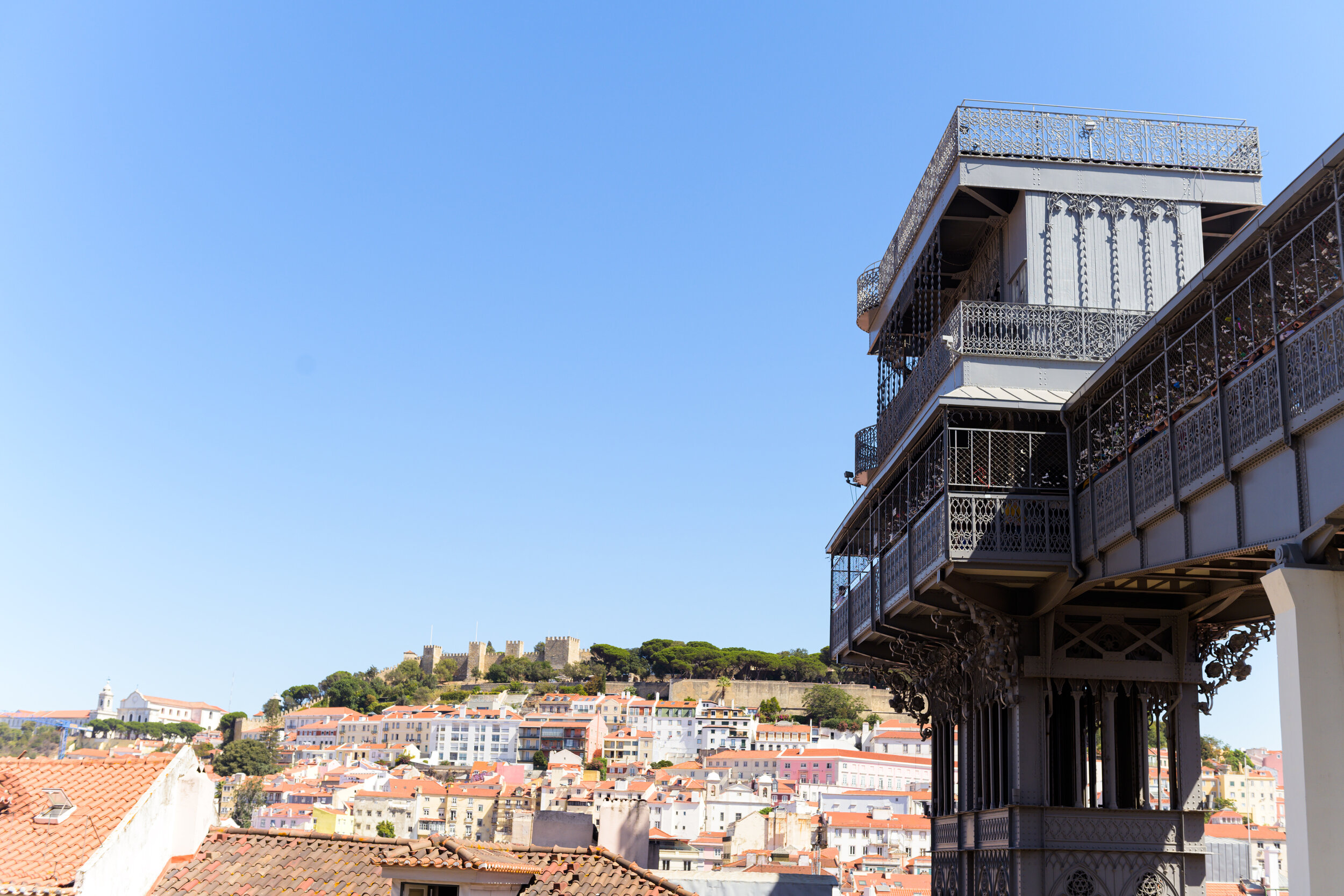BEM VINDO A LISBOA!
Welcome to Lisbon (AKA Lisboa to the Portuguese and us for the purposes of our posts), Portugal’s capital and largest city. The importance of Lisboa is its strategic location at the mouth of the Tagus River, the longest river in the Iberia Peninsula - divided between Portugal, Spain, Andorra, France, and Gibraltar. The harbor is naturally sheltered making it a significant seaport for trade between the Mediterranean Sea and northern Europe throughout history.
One of the oldest cities in western Europe, Lisboa’s history can be traced back to 800 B.C! The area has been occupied by many civilizations including the Carthaginians, Romans, Visigoths, and Moors, among others. This established a unique mix of culture, history, and architecture throughout the area. Though much of how the city appears today was defined by a terrible natural catastrophe in 1755.
On November 1, 1755, an estimated 8.5–9.0 magnitude earthquake hit Lisboa in the Kingdom of Portugal. It caused extreme structural damage to many of the buildings. Additionally it knocked over lit candles in churches, shops, and homes starting several deadly fires. Combined with a subsequent tsunami from the aftermath, Lisboa was left almost totally destroyed. Shocks from the earthquake were felt around the country—coastal villages in the Algarve and even inland castles experienced heavy damages. Considered one of the deadliest earthquakes in history, the death toll in Lisboa is estimated between 10,000 and 100,000 people.
This earthquake shaped much of the country. Palaces, cathedrals, churches and homes were destroyed and although over following centuries many were repaired and restored, others were left to fall into ruins. Additionally priceless artifacts, paintings, historical records, and books were lost. Throughout the country you’ll find areas such as the Alfama district in Lisboa with parts dating back nearly 800 years, but due to the earthquake the next neighborhood over, Baixa, dating back less than 300 years. This catastrophe greatly shaped the county, the city, and its history.
The concentration of buildings and the population of Lisboa are around Baixa, the now downtown, which was established on the original palace grounds prior to 1755, although it is worth exploring the surrounding neighborhoods of Chaido, Bairro Alto, Alfama, Graça, and the further out districts of Belém and Sintra. Note: This itinerary will try and cover most of these for you. :)
I know you’ve just arrived in the city, but since both Belém and Sintra are worth an entire day trip I wanted to spread them out in the itinerary. Today is about exploring Belém and getting oriented in this colorful, lively city!
BELEM
Belém is about 6 miles (9 km) from Lisboa’s Baixa which means (unless you’re super into fitness), you’ll need to either hire a car or take a tram. I’d recommend the trams. The yellow vintage trams in Lisbon definitely oozing old-world charm. To get to Belém from downtown Lisboa there are two tram options—tram 127 or tram 15 from either Praça da Figueira or Praça do Comércio. The number is 15 is more direct and takes about 25 minutes. Get off at Largo da Princesa, just two stops past the osteiro dos Jerónimos stop.
Tickets can be purchase onboard, just make sure you have exact change. A single, one-way ticket costs €3; although, you can purchase a Viva Viagem 24-hour public transit ticket from metro stations which costs €6,40 and include all trams, metro and buses in the city. The ticket also includes the Elevador da Glória and Elevador de Santa Justa which would cost €3,80 and €5,30 respectively.
8:15 A.M. — Let’s grab some brekkie! If you’ve chosen Praça da Figueira as your tram starting point, head to Confeitaria Nacional (Praça da Figueira, Praça Dom Pedro IV 18B, 1100-241 Lisboa, Portugal) , the oldest pastry shop in Lisboa. Most of their recipes date more than 180 years old. It’s been owned and run by the same family for six generations!
If you’ve chosen Praça do Comércio as your tram starting point, head to Fábrica Lisboa (R. da Madalena 121, 1100-319 Lisboa, Portugal), a delicious bakery renowned for their croissants. Yum!
9:30 A.M. — Hop aboard your tram and starting point of choice.
The Belém district of Lisboa is filled with parks, plazas, and historically significant “attractions.” It is more laid-back than the city centre and especially popular, even with locals, on the weekend for a refreshing break from the hustle of the city.
The area was originally the shipyards and starting points for many important 15th century voyages and trading opportunities during Portugal’s Age of Discovery. Many of the buildings were constructed with the wealth acquired from the trade and exploration at the time.
NOTE: The Torre de Belém, Padrão dos Descobrimentos, and Mosteiro dos Jerónimos are all closed on Mondays.
RELATED: For the details of the sights in Belém, check out my Travel Guide | Belém, Portugal.
10 A.M. — Let’s start at the furthest point and work our way back towards Lisboa. First up, the Torre de Belém (Av. Brasília, 1400-038 Lisboa, Portugal). Do note that if you plan on going inside it’s best to arrive early to avoid the tour buses. There is usually a bit of a queue and inside there are nearly 100 circular steps in a narrow path up the tower.
11 A.M. — Continue west along the riverfront to the Padrão dos Descobrimentos, The Monument of Discoveries (v. Brasília, 1400-038 Lisboa, Portugal), a towering monument on the banks of the Tagus River. If you’re not sure where to go simply follow the flow of people. You can’t miss it!
11:30 A.M. — You’ll see the Mosteiro dos Jerónimos (Praça do Império 1400-206 Lisboa, Portugal) just across the road, but you’ll have to take a short detour that includes a pedestrian tunnel to get to it safely. The monastery is one of the most prominent example of Manueline style architecture in Lisboa. Purchase a ticket inside the main entrance of the Museu Nacional de Arqueologia - it’s in the same complex - then take your time soaking in all the beauty. Don’t miss the cloisters. :)
12:45 P.M. — Now’s the time to fuel up for the rest of the day. I’d recommend a larger meal since dinner will be later tonight. Try Prova - Enoteca (9E, R. Duarte Pacheco Pereira, 1400-139 Lisboa, Portugal) or Pao Pao Queijo Queijo (R. de Belém 126, 1300-086 Lisboa, Portugal), which was recommended several times to us.
2 P.M. — Full? Good, onward! Head to Museu Nacional dos Coches, a museum boasting the largest collection of historic horse-drawn coaches in the world, located inside the Royal Riding School on Praça Afonso de Albuquerque. The museum is actually divided between two buildings—the 18th-century Royal Riding School at the palace and the Novo Museu (Av. da Índia 136, 1300-004 Lisboa, Portugal). Head to the original museum first and make sure you purchase a ticket for both collections.
4 P.M. — You can’t say you've been to Portugal without tasting a pastel de nata, Portugal’s signature sweet treat. Pastel de natas are egg custard tarts dusted with cinnamon—flaky pastry crust filled with warm, sweet custard. Pastéis de Belém (R. de Belém 84 92, 1300-085 Lisboa, Portugal) is famous for their pastel de natas which are recreated from an ancient recipe from the Mosteiro dos Jerónimos. Chances are there will be a queue, but it moves quickly. Today was busy and you deserve a treat so grab one (or five). Enjoy!
Note: Keep an eye on the time and traffic as to what time you need to leave Belém in order to make it your meeting place for the tour this evening on time.
Though you’ve only been in Lisboa for less than a day, by now you’ve noticed there are tuk tuks everywhere. I’m sure if you’re a local they are annoying, but as a visitor they are a great way to see the sights (without having to climb each of Lisboa’s seven hills).
We LOVED our tuk tuk tour with Eco Tuk Tours, the first company in Portugal with a full fleet of eco-friendly, tuk tuks. Since they’re electric, you can actually hear what your guide is saying. Plus no pollution. Note: I’d recommend booking ahead of time so you have the best selection of times available. When you book you also book your pick up and drop off locations.
They have a ton of different tour options to choose from. There’s a Old Town Lisbon, Tram 28 Route, Belém, and even a Food Tour. We opted for their “À La Carte 2 Hour Tour.” It is kind of a we’ll-do-what-you-want tour. If you want to hire it to get you from site to site during that time frame, that’s an option. If you have some places you’d like to see, just let them know. These tours can be as hop on, hop off as you’d like. We just told our awesome guide, Sharky, that we’d just gotten into Lisboa the night before and hadn’t seen anything yet so he took us on a driving tour of the major (and some hidden gems) of the city to learn about its history, people, architecture, and get a better understanding of the layout of Lisboa. Eco Tuk Tours offer 1 hour to 5 hour long À La Carte tours so you can make it work for you. Note: Especially if you take an evening tour, ask your guide to stop by several of the miradouros (viewpoints) around the city. They are particularly beautiful during the golden hour and reward visitors with fabulous views over the city.
Some of the best miradouros include:
- Miradouro de Santa Luzia
- Miradouro da Nossa Senhora do Monte
- Miradouro da Graça
- Miradouro das Portas do Sol
- Miradouro de São Pedro de Alcântara
- Miradouro do Parque Eduardo VII
- Elevador de Santa Justa (skip for now, we’ll do it another time)
Note: If you decide to take a guided bus tour, DO NOT take the red City Sightseeing Portugal Lisbon bus. We love hop on, hop off buses and have enjoyed their tours all around the world, but this one had NO information. It was very disappointing. We hopped off at stop 7 and never got back on.
5:50 P.M. — Meet your tuk tuk tour guide at the designated meeting place.
6 P.M. — Enjoy your tour! For planning purposes on this itinerary you decided to go with an À La Carte 2 Hour Tour since it’s the only one we can actually attest to.
8:15 P.M. — Hopefully you enjoyed the tour as much as we did - and learned a little along the way. :) There are TONS of restaurants, cafes, and bars in Baixa especially along Rua Augusta. Stroll around you’re sure to find something that you’re craving for dinner.
For a vegan option: We loved Veganapati (Rua da Prata 242, 1100-423 Lisboa, Portugal) and ate there a couple times while in Lisboa.
Other vegan options we enjoyed were Organi Chiado (Calçada Nova de São Francisco 2, 1200-300 Lisboa, Portugal) in - as the name suggests - Chiado, and daTerra Restaurants Vegetariano (R. da Rosa 51, 1200-043 Lisboa, Portugal) in Bairro Alto. Note: Organi Chiado was our favorite, YUM!
Round out your meal with some Ginja, a sweet Portuguese liqueur made by infusing sour Morello cherries in alcohol with sugar. Sometimes it is served in these cute little chocolate cups and sometimes with a piece of fruit in the bottom of a cup. Both delicious, definitely give it a shot! Note: We were told that pronouncing it like “ginjinha” makes it sounds more like how locals pronounce it. If you’re feeling up to it, head to Ginginha do Carmo (Calçada do Carmo 37 A, 1200-090 Lisboa, Portugal) where Ginja is their speciality. They close most nights at 2 a.m.
9:45 P.M. —The night is yours. Head out and explore the nightlife like the options along The Pink Street (R. Nova do Carvalho, 1200-372 Lisboa, Portugal) in Cais do Sodré, simply wander around Baixa, kick back by the waterfront of Praça do Comércio, or head back to your hotel. Have fun!
ALFAMA
Today we’re heading to Alfama, Lisbon’s oldest district. Thankfully for the most part Alfama did not suffer damage from the earthquake in 1755 like the rest of the city did and therefore the picturesque narrow, cobbled laneways and small squares remain. In fact this section of Lisbon is more than 800 years old!
The medieval castle, the Castelo de São Jorge, overlooks Alfama was the royal residence until the early 16th century. Along the slopes of this district you’ll find several miradouros - all which offer different panoramic views of the city. The laneways are filled with cozy eateries, local shops and the melancholy sounds of Fado. Additionally Alfama is home to many important historical attractions.
9 A.M. — On your way to Alfama (depending where your hotel is) you'll probably pass through Baixa, which is packed with bakeries and coffee shops. Find something to fill you up. As in my typical itinerary fashion, we've got lots to see. :)
9:30 A.M. — Built to commemorate the city’s reconstruction after the 1755 earthquake, Arco da Rua Augusta’s inscription reads in Latin “The Virtues of the Greatest: the strength, resilience and achievements of the Portuguese people.” Visitors can take in the view over the plaza and back towards the city from the top of the triumphal arch. We didn’t feel the need to go up to as there are literally 100s of viewpoints around Lisbon, but its up to you.
Whether you take in the view from the top or not, you’ll be able to enjoy the Praça do Comércio, the Square of Commerce. Opening up to the Tagus River this plaza was the location of the Paços da Ribeira (Royal Ribeira Palace), which was destroyed by the earthquake of 1755. As part of the rebuilding of the Pombaline Downtown, the plaza was designed to serve a greater function in the economy of Lisbon.
By walking through Baixa you'll notice the grid pattern is much different than the rest of Lisbon because post-earthquake the new downtown was rebuilt as some of the first examples of earthquake-resistant construction. They had to start from scratch after 1755.
The Praça do Comércio is filled with people 24/7. People sit by the river to enjoy the sunset in the evenings, others enjoy meals at surrounding restaurants. Some simply sit and enjoy people watching. There are vendors and meet ups and people waiting to catch the next tram.
10:15 A.M. — Make your way to the Alfama district. If you see somewhere to stop and shop, go for it. Take your time and enjoy the charming ancient streets of Lisbon’s oldest district. Enjoy some leisurely shopping, cafes, and along the way you’ll see some beautiful churches from the city’s diverse history. Stop in and check them out if you feel compelled to.
- Igreja Nossa Senhora da Conceição Velha (Rua da Alfândega 108, 1100-585 Lisboa) - The church dates from the 15th century, but only the portal of the church remained after the earthquake of 1755. It’s a beautiful example of the Manueline style with carved angels, flowers and crosses.
- Se do Lisboa - Dating from the 12th century, Se do Lisboa is the oldest and most important church in Lisbon. The Romanesque building survived the earthquake of 1755, but over time has been renovated and rebuilt. There are relics on the second floor.
- Igreja de Santo António de Lisboa (Largo de Santo António da Sé, 1100-401 Lisboa) - Dedicated to Saint Anthony, the patron saint of Portugal, this late-Baroque style church is actually built on the location of Saint Anthony’s birthplace. Throwing (and landing) a coin in the book of Saint Anthony on the statue in front of the church is good luck for love.
12 P.M. — There are SO many restaurants in this area. We ended up Princesa do Castelo (Rua do Salvador 64A, 1100-466 Lisboa) , a vegan spot. It wasn’t the best vegan meal we had while in Lisbon but it was affordable and the portions were HUGE! They even have vegan pastéis de nata!!
1 P.M. — Along your route is the National Pantheon. Original a church the building was converted in the 20th century to the National Pantheon which now is the final resting place for important Portuguese people including presidents, football players, singers, writers. In order to be nominated/selected to be included in the pantheon you must have made significant contributions to Portuguese culture of history.
If you missed the Miradouro Saint Luzia or Portes dol Sol on your tuk tuk tour yesterday, I'd highly recommend checking it out. They’re beautiful spaces with amazing views. There are always street performers, artists, and musicians.
As you continue to wander you may come across pieces of Muralha Moura, remaining pieces of the most ancient defensive alls. They were constructed by the Moors in the middle of the 11th century.
Also in this area you may see:
- Igreja de São Miguel (Largo de São Miguel 6, 1100-117 Lisboa) which dates back to the 1100s. It was rebuilt in a Mannerist and Baroque style before surviving the earthquake of 1755. Its unassuming exterior houses one of the richest gilded decorations in the city and several significant paintings. Apparently its extremely opulent. Unfortunately the sign out from said that the church is only open during mass.
- Igreja de Santo Estêvão (Largo de Santo Estêvão 13, 1100-219 Lisboa). The church was heavily damaged after the earthwuake of 1755 and reconstructed in the Baroque style. The sign out front said it was only open during mass, but the outside was lovely.
2:30 P.M. OPTION 1: You’ll learn more about Fado this evening, but as the country’s traditional music there's a whole museum dedicated to Fado's history - Museu do Fado (Largo do Chafariz de Dentro 1, 1100-139 Lisboa). Fado was born in Alfama so it's a significant museum as it documents not only the history of the genre but the birthplace of this tradition. There's an audio guide for the museum tour.
2:30 P.M. OPTION 2: I would personally chose this option. The Mosteiro de São Vicente de Fora (Largo de São Vicente, 1100-572 Lisboa) was founded in the 12th century. Over the centuries many renovations and additions have been made resulting the gorgeous example of Mannerist style you see today. The church's names means “St. Vincent Outside the Walls" because it was the first church built outside the fortified city walls.
This is the pantheon for the last Portuguese dynasty, the Braganza. You can walk around the original cloisters and see an ancient cistern. They have a fabulous collection of decorated azulejos inside—someone even told us that they have more tiles (in numbers) than the National Tile Museum. There were a TON! Don’t forget to take in the view from the rooftop. It’s wonderful.
I believe it’s the first Saturday of each month the church puts on a free public organ performance. So if that lines up, it may be something to check out.
3:45 P.M — Hop in an Uber for quick ride to the National Tile Museum.
There's no shortage of tiles in Portugal (my camera phone was full of pictures of them) and the Museu Nacional do Azulejo (R. Me. Deus 4, 1900-312 Lisboa) is dedicated to the beautiful azulejos, the traditional tilework of the country. Inside you'll find one of the largest collection of ceramic tileworks in the world. They even have a great audio guide app you can download to guide you through the museum. It also provides in-depth background information on how the tile process has changed throughout the years and the different influences different cultures had on the design. Get your camera ready!
6 P.M. — Catch a ride back to your hotel to freshen up or grab a snack and make your way to the tour meeting place.
By now you've probably heard people talking about and places advertising Fado, or if you visted to museum earlier you probably know a bunch more now. Fado is a popular type of Portuguese song. It usually is very melancholy, featuring a singer and 1-2 mandolins or guitars. When traveling you've got to immerse yourself in the culture, right? so tonight it about Fado.
Book the Sunset Fado & Dinner Tour with Urban Adventures. Urban Adventures is one of our favorite travel tour companies and we have enjoyed tours in Paris, Moscow, London, and even D.C. with them. You’ll want to book the tour in advance as the group is small and therefore spots fill up quickly.
The tour includes a sunset city tour, Portuguese tapas, an intimate Fado performance, some wine and even a sampling of Portugal’s famous Ginjinha liquor.
6:50 P.M. — Meet your guide and tour group at the designated meeting place (In front of Hotel Mundial – Martim Moniz Square; Praça Martim Moniz 2, 1100-341 Lisboa, Portugal, as of September 2019).
7 P.M. — Enjoy your Sunset Fado & Dinner Tour!
10:30 P.M. — After the tour which ended in Alfama for us, grab some dinner unless you really filled up on tapas during the tour. :) A couple great recommendations we got were As Bifanas do Afonso (R. da Madalena 146, 1100-340 Lisboa) a go-to for bifanas, Portugal’s famous pork fillet sandwiches. Gotta try that local cuisine, right? This is a more grab-and-go option.
Another option would be to head back to Baixa and down Rua Augusta. It’s definitely more tourist-driven but there are tons of spots that are open late with large menus and affordable prices.
Good morning! Today we’re going to explore two of the city’s trendiest neighborhoods—Bairro Alto and Chiado, but first coffee and crepes! ;)
Grad a coffee or tea at Copenhagen Coffee Lab (Tv. Corpo Santo 7, 1200-131 Lisboa, Portugal), a hipster cafe and coffee roastery. Then head around the corner to Sama Sama Crepe and Juice Bar (Travessa Corpo Santo 7, Lisbon 1200-131, Portugal) for a breakfast. This little grab-and-go cafe offers a variety of crepes and fresh-pressed juices, the majority of which can be made vegan. YUM! They only have a couple of seats outside, but are allowed to use the outdoor seating at the Irish Pub around the corner.
First up, Chiado. This neighborhood is the most fashionable district of Lisbon. Here You’ll be able to enjoy tons of local and international shopping, a mix of cafes and restaurants, any historic sites, and even the stylish theatre district. If you see something you like, by all means check it out and remember your on vacation so TREAT YO SELF a little too. :) Note: The itinerary activities today aren’t set times so enjoy yourself, hit the attractions and stop if you see somewhere you want to check out. Go off the main paths and discover the beauty of the neighborhood’s graffitied laneways.
Lisboa’s seven hills makes exploring by foot a bit more of physical workout than say an afternoon of exploring in Kansas, which is why back in the 1890s several funicular routes were installed. The most photographed cars are these of the Ascendor da Bica and Elevador da Gloria. I would say that Elevador da Gloria is the more popular of the two, although both are basically tourist attractions now. These are not true funiculars as the cable links the cars together as counterweights so they ascend and descend simultaneously.
In Chiado, Ascendor da Bica was inaugurated in June 1892. Don’t want to wait for the car? No worries, the route runs between a lane lined with staircases and graffitied buildings.
In Bairro Alto, Elevador da Gloria was inaugurated in October 1885. This is the “steeper” route with a 17.7% grade and I would argue the busier of the two.
When we visited both accepted the Lisboa Card or cost the regular public transit price of €3.80 per person with departures every 10-15 minutes.
Next up, Bairro Alto. Literally translating to “Upper District,” Bairro Alto is a trendy neighborhood known for its nightlife. It’s chock full of cozy bars, renowned restaurants, small cafes, and intimate venues. It’s great during the day but really comes alive in the evenings.
11 A.M. — Technically our first official stop: Ingreja de Sao Roque. Compared to others chapels, churches, and cathedrals in Lisboa the exterior of Ingreja de Sao Roque is quite unassuming; however, its interior boasts some of the finest Portuguese Baroque design. Its ornately carved details are covered in gold leaf. Supposedly the alter is one of the most expensive ever constructed. It was even blessed by the Pope.
Take a short walk to The Jardim de São Pedro de Alcântara, another miradouro. This large plaza has amazing views across Baixa and the city over to The Castelo de Sao Jorge.
This is where you’ll also find the Elevador da Gloria, which connects Restauradores Square with Rua San Pedro de Alcántara.
This area has is full of places to grab a bite or snack. There’s a bit of everything so find what you’re craving. Lost In (R. Dom Pedro V Nº56-D, 1250-094 Lisboa), also known as “Lost in Esplanada" came to us highly recommended and was quite delicious. It is a beautiful place, the service was efficient, and the food was simple yet tasty. The views were amazing. Grab a drink and stick around for a bit if you want.
1 P.M. — Right down the road is the Igreja do Carmo & Museu Arqueológico do Carmo, a beautiful Gothic medieval convent that remains in ruins as a reminder of the devastation of the 1755 earthquake (refer to the itinerary intro for a refresher). The Catholic convent was originally founded in 1389. Nowadays the nave and apse of the church are now a small but important museum of archaeology and art with significant sculptures, tombs, and other relics. It’s fabulous to wander through and admire the beauty and strength of the structure’s remaining integrity. Huge columns supporting ribbed vaulting extend into the open sky above…stunning! My bet is it is particularly lovely during golden hour. Note: The ticket includes a free audio guide which you can pick up from the small gift shop in the open nave. It’s not advertised well but was filled with lots of good information.
2:30 P.M. — When you entered Igreja do Carmo you probably walked through the square out front. This is Largo do Carmo, one of the most picturesque squares in the city. The square is a perfect place to eat a snack (or drink) or relax for bit and simply enjoy the beautiful jacarandas trees, historic monuments, and lovely surrounding Baroque style houses.
Walk around to the southern facade of Igreja do Carmo and head towards the signs for Bella Lisa Elevador (Largo do Carmo Elevador de Santa Justa, 1100-998, Portugal). It’s a restaurant and literally looks and feels like your going to the restaurant - which you are more than welcome to if you want some food or drinks with amazing views - but you have to pass through it to get to the top of the Elevador de Santa Justa.
By now I’m sure you’ve seen the Elevador de Santa Justa jutting up from the historical center of Lisbon. Opened in 1899, this iron Neo-Gothic elevator connects the lower streets of Baixa with the Largo do Carmo (where you are now). It’s the only remaining vertical elevator - the rest are graded “funicular style” ones - and it’s observation deck is boasts one of the best views of the city.
At the bottom of the structure in Baixa, there’s always a line of tourists but form the top you can enjoy the view without the queue or paying. The “free” view is one level down from the top deck but essentially the same. There is a short spiral staircase you can take to the top, but you’ll have to pay to walk up and then ride down. Between all the miradouros and the second level view we didn’t feel the need to go to the top, but do what you feel.
Personally I’d skip the drinks at this bar and upper deck of the elevator and head to Cafe A Brasileira (Rua Garrett, 120 Lisbon), one of Lisbon’s most iconic cafes. Take a selfie with the statues of poet Fernando Pessoa out front then head inside for a “bica,” AKA a coffee with sugar. The cafe was a popular 19th century hangout for Portugal’s intellectuals.
Chances are the section above won't take you several hours to complete. I wanted to leave plenty of room for exploring the streets of Chiado and Bairro Alto. It's a fabulous place to find unique gifts and move at that more relaxed pace that Portugal is known for. If you need some down time, by all means head back to your room, relax, and then freshen up for the evening.
6 P.M. — Lisbon's red light district has been revitalized into the city's Pink Street nightlife district and is now one of the coolest bar-hopping spots. The color blocking of The Pink Street, also known as Rua Nova do Carvalho, and its surrounding buildings also make it one of the most popular photo spots in Lisbon. Take your pics now and scope out where you might want to go later (if that nightlife-life is for you). Haha.
6:30 P.M. — Located inside the landmark Mercado de Ribeira, Time Out Market (Av. 24 de Julho 49, 1200-479 Lisboa) is a warehouse-sized food hall. The original fresh fruit and veggie stalls still occupy part of the building but the focus is now on the bustling food hall and 30+ eatery concepts. Keep a lookout for a few which were opened by Michelin-star chefs. It's a great place to meet up with people, grab a quick bite, and people watch. Note: It can get quite loud inside and the lines can get quite long especially late in the evenings and on the weekends.
8:15 P.M. — Hop in an Uber and head to LX Factory (R. Rodrigues de Faria 103, 1300-501 Lisboa). LX Factory was an abandoned factory site that has been restored and transformed into a hip cultural area. The renovated buildings now hold everything from beer gardens/bars and event venues to artist workspaces, locally owned shops, and a variety of cafes and eateries. One can't miss stop is Ler Devagar, an amazing bookstore that's now insta-famous! Note: They host a weekly market on Sundays.
Late Night — Head back to The Pink Street for some nightlife if you desire or out wherever the night may take you.
SINTRA
Located just 30 km from Baixa Lisbon, throughout history people have flocked to Sintra for its proximity to the ocean, beautiful foothills and agreeable climate. It served as a strategic fortress as well as the location of several summer residences of the Portuguese royal family and wealthy patrons.
Now its a resort town and popular tourist destination due to its multiple hilltop palaces and castles. A quick Google and you’ll see why.
If you can spare an extra day in Sintra, it’s definitely worth it but if not, a day trip is still worth it. Just be warned that it will be a busy, packed day. Be prepared to walk! That means uphill, upstairs, through gardens….make sure you wear comfortable footwear. I’d also recommend packing some water and snacks in case you get hungry before you make it back to the town center.
Before you arrive check out The Parques de Sintra’s website and their ticket office where you can purchase tickets ahead of time, most with a 5% online purchase discount. Save money and save time by avoiding the ticket lines at each attraction.
They represent the following:
- Parque e Palácio da Pena
- Palácio de Sintra
- Palácio de Queluz
- Castelo dos Mouros
- Parque e Palácio de Monserrate e Convento dos Capuchos
GETTING THERE — The best way to get from Lisbon to Sintra and back again is hopping a train from Rossio Station. The ride is roughly 40-45 minutes and costs a mere €2.20! The ride is smooth and there are about 7-ish stops between the two stations. There is at least one train every hour along the route. Note: Confirm departure times by checking current train schedule and adjust this itinerary accordingly.
Note: Purchase your train tickets the night before in order to avoid the morning rush, especially if you’ve visiting Sintra on the weekend. If that's the case, switch this day with another on the itinerary if possible!
8:50 A.M. — Train from Rossio station to Sintra (43 minutes)
10:00 A.M. — Arrive Sintra station. Today is going to be a lot of walking and of course you’re welcome to walk to our first stop, but in an effort to beat some of the tour buses I’d recommend hopping on a tuk tuk to save some time. Note: There was a fire advisory due to dry weather when we were in Sintra and many of the roads were closed to tourist traffic so our tuk tuk wasn’t allowed to take us to the entry of the attraction, However they could take us the majority of the way. If that's the case, just take one as far as possible then walk the remainder of the way.
Many of the castles are on hilltops (as you’ll be able to see from the town center), but the “hike” uphill wasn’t as bad as we expected. The paths are more windy than vertical. Don’t get me wrong you are going uphill and luckily the majority of the roads are canopied by trees.
Note: This itinerary includes the top sights; however, it is A LOT to do in one day while trying to stay within opening hours so I’d recommend doing a bit a research before and deciding which ones are must-sees to you so you know which can be optional if you find you're running out of time. I always think it’s better to see more of less than less of more, if that makes sense.
For more info about Sintra, check out my Travel Guide | Sintra, Portugal.
10:15 A.M. — Let’s start with the most popular attraction in Sintra—Palácio da Pena & Parque da Pena (Estrada da Pena, 2710-609 Sintra, Portugal). Designed by King Fernando II, this elaborate 19th-century Romanesque Revival style palace was their royal summer residence. The mix of colors, tiles, and architectural styles are iconic in Sintra. Note: As it is perhaps the most popular palace be prepared to encounter some crowds and lines. Hopefully by arriving early you’ll beat most of them.
The palace’s park is more than 200-hectares so chances aren’t you won’t see all of it. Grab a map from the ticketing counter and enjoy some time wandering along the pathways admiring the beautifully groomed foliage and sculptures.
SINTRA DAY Check out the travel guide
12:15 P.M. OPTION 1: Follow the signs for a short 20-ish minute walk to the neighboring Castelo dos Mouros (2710-405 Sintra, Portugal) which you probably saw from Pena Palace. Remember those steps you’ll be racking up during your time in Sintra? Well the Castle of the Moors will be responsible for a whole bunch of them. :)
Constructed in the 9th century, this fortified stone castle was built by the Moors during their occupation of Portugal. The views from its hilltop of Serra De Sintra are incredible. There’s not a lot of information about the castle when you finally reach it, but walking along the castle walls for the panoramic views of the Sintra region extending to the Atlantic Ocean, is worth every step. Just imagine all the people who walked there before you. We also like to imagine how people even managed to construct such amazing structures way back when.
Note: I loved this castle, but due to the lack of information and views similar to Pena Palace if you’re running short of time, I’d recommend making this attraction you’re optional one. If you want to do it, just adjust the remaining attraction times in the itinerary to fit your schedule.
Soooo….if Castelo dos Mouros was you’re optional attraction, head back down to the center of town. It’s downhill and a straight forward 30-minute walk, but how you get down is up to you. Just remember to budget walking or transportation time into your day plan.
12:15 P.M. OPTION 2: Once down the hill, head to the Palacio Nacional de Sintra (Largo Rainha Dona Amélia, 2710-616 Sintra). Known as the “town palace,” it’s the best preserved medieval royal palace in Portugal and is typically less crowded than its hilltop counterparts. You’ll also notice that it’s much more simplistic white-washed exterior; however, inside you’re find decorative and colorful state rooms as well as a peaceful walled courtyard. It now serves as a historic house/museum.
1:45 P.M. — By now with all those steps you’ll be hungry so grab some lunch in the town center. Along the way stop by Camara Municipal de Sintra (Largo Dr. Virgílio Horta, 2714-501 Sintra), the town hall. This is not your typical town hall. Camara Municipal de Sintra is rather extravagant with a massive clock tower, large chimneys, and spired roof. The green and white tiling tops off the design. It even includes the Portuguese coat of arms. It’s also relatively new having only been constructed at the turn of the century. It looks like a fairytale castle!
There are tons of restaurants in Sintra and most have their menus out front so you can check them out. Saudade (Av. Dr. Miguel Bombarda 8, 2710-631 Sintra) has lots of baked goods and hot sandwiches. They even some some with gluten-free bread! Alternatively Bengal Tandoori Restaurant (Tv. Pendoa 11, 2710-557 Sintra) is an Indian/Italian restaurant (which sounds like an odd combo), but really means everyone will be able to find something. Many of the Indian plates were vegan and the portions were huge!
2:45 P.M. — Just down the road you’ll find Quinta da Regaleira (R. Barbosa du Bocage 5, 2710-567 Sintra). The estate served as a private residence for many owners, most notably the original owners, the Viscountess of Regaleira, a merchant family from Porto and is complete with a beautiful Gothic residence and chapel among a lush hidden forest wonderland. It’s like you’ve stumbled upon a long lost civilization in the jungle—stone towers, grottos, waterfalls, mysterious symbolism, and hidden passageways.
Been searching for that underground staircase all over Instagram? Well this is the place! It’s the larger of the two inverted towers or initiation wells.
You can book a two-hour tour ahead of time or simply get the audio guide for a self-guided tour. Depends on how much time you have to spend in this marvelous place.
4:45 P.M. — We could have easily spent the rest of the day at Quinta da Regaleira but believe it or not there is more to see. From here either take a 30-minute walk or 7 minute tuk tuk ride to Palacio de Monserrate (2710-405 Sintra). Note: The opening hours vary with the season so check ahead.
Also known as Monserrate Palace, this elaborately decorated Romanticism and Mudéjar Moorish Revival influenced mansion was once a summer home for Portuguese royalty. Beautifully painted Gothic arches, bold colors, and a formal botanical garden. It’s stunning! Just check Instagram.
7 P.M. — Head back to Sintra’s town center. Depending on what you want to do, you can:
Option 1: It’s been a long day with a crazy amount of steps (check the Health app on your phone). If you’re done, no worries just head towards the train station.
- 7:50 P.M. - 8:30 P.M. — Train from Sintra station to Rossio Station When you arrive grab dinner in Lisbon.
Option 2: By this time of day the majority of the tourist buses and crowds have departed Sintra, leaving the small, quiet town just that - small and quiet. It’s wonderful walking around when the area is peaceful and a greta opportunity to try another one of the town’s fabulous restaurants. Try:
- Giallo d’oro (Av. Augusto Freire 2, 2710-590 Sintra) and their famous pizza and desserts!
Then catch a later train from Sintra station back to Lisbon’s Rossio Station.




